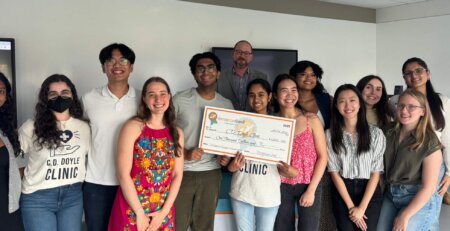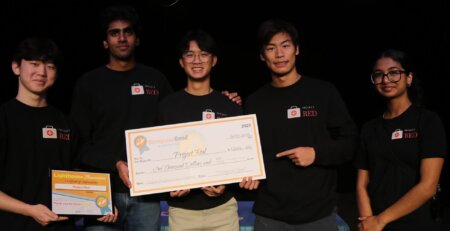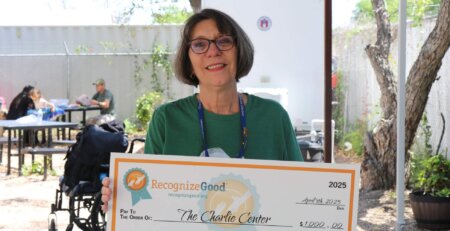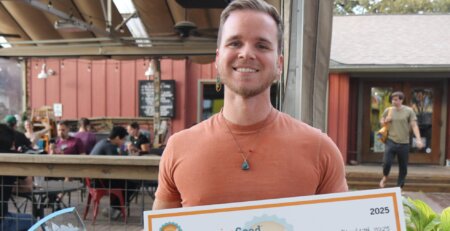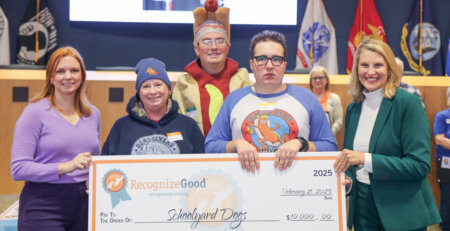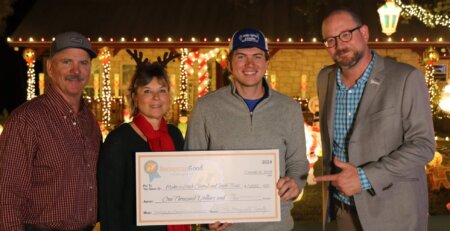Doing Good Better: Leadership Austin Fellows – Debbie Johnson + Leadership Austin
Amit2024-01-22T17:59:07-06:00People do good for others every day in the community surrounding Austin. At RecognizeGood, our mission is to help strengthen that community by sharing those inspiring examples. In our Doing Good Better series, we take a docu-series look into innovative collaborations around the Austin area that make our community stronger. Leadership Austin launched a pilot Fellows Program to connect experienced retirees with sustainability-building projects that nonprofits often don’t have the resources to execute. Projects that require a different caliber of candidate.
To head up the program, Leadership Austin recruited philanthropy expert and community leader Debbie Johnson, becoming its own first beneficiary of the Fellows Program it was launching and experiencing first-hand how the initiative would work with other nonprofits.
“We don’t want just somebody to walk in like an automaton and say, ‘Well, I can do this project,’ but really not care about the cause of the organization. We thought that the better match would be if they really cared and knew what the organization wants to accomplish. I think the true north is making sure that that experience was really, really great for both parties.”
RecognizeGood: Christopher, tell me tell me the origin story of this Fellows Program. How did the idea get planted and grow?
Christopher Kennedy, CEO at Leadership Austin: This whole thing came out of our strategic plan Leadership Austin a couple of years ago. One component [of the plan] talked about the changing demographics of our region, and this entire Fellows Program was anchored in that demographic discussion. Most folks don’t know that for as much press as we get in Austin for the 25-40 year-old growth, we’re number one in the country of 55-64 year-olds. We’re number three in the country of 65 plus. When you sit down with the city demographers and talk about it, what they say is that there are four things that attract this age cohort to this region. One is they like the weather; they think the weather’s pretty good. Two, they like to be around a research institution, a university like the University of Texas because that brings a character to the community. Three, they define it to be somewhat still affordable, depending on where they’re coming from. And four, which is the largest piece, is they want to be around their grandkids. So our 25 to 40 year old community is bringing their parents too because they want to be around their grandkids. Our strategic plan looked at that demographic and said, that’s an audience that we think we are not yet serving. We explore different programs on what best way to go, we brainstorm three different lanes that we’re going to go explore to serve that age cohort. The Fellows program was the one [of the three ideas] that seemed to resonate with the community first. That’s how we advanced it.
RG: Debbie, tell me the origin story of how you found out Leadership Austin was going to do this for you. Was there already a strategic plan in place and then you were brought in later?
Debbie Johnson, Leadership Austin Fellows Director: Good question. Well as you may or may not know, I was on the board for a number of years, and I had already chaired the board. I’m very familiar with the organization. I love Leadership Austin and as part of that board membership, we’d had a strategic plan in place for a long time. We do our strategic plan about every five years. I have been familiar with this whole question of whether or not there was anything that Leadership Austin should be doing in the retiree, older population space. We had looked at it from several different angles; the effort was in our strategic plan, but we had not found quite the right program match for what we thought we should be doing. There was a national model called Encore that came to our attention, as well as to the attention of the St. David’s Foundation. That seemed to be a pretty good fit for what we might want to do.
At that time, I was leaving the board, so that summer, which was now three years ago, I told Christopher I was done. I felt it was my time to leave. I’d already been on the board eight years. But I said, “You know, I love you. I’ll do anything for you.” He tried to talk me into staying, and I said, “No, really, it’s time for me to go, but I’ll do any anything for you within reason.” Two months later, he came back and said “I have just the thing!” It happened to be this Encore program that they had uncovered. St. David’s Foundation has basically stepped up and said they would be willing to work with us and fund this. We had always told Christopher that you’re not going to be able to start a new program unless we have the funding first because it’s really tempting to go do a bunch of stuff and then go chase funding. As board members, we had already said,” No, we’re not we’re not doing that. We’re going to do the reverse – go find the funding and then we’ll consider a program.” It was really important for us to pilot this first and see if it really we thought it would work for Austin. With that, it turns out I am in that cohort of retiree, or semi-retiree – I have several businesses but I’m trying to scale back a little bit. It’s really kind of the perfect match, and I think he thought I had the skill set to become the first Fellow, figure out what this looks like and then run it for him.
RG: What was the development process like from your end? Was it looking at Encore, picking and choosing the parts that you liked and filling in the gaps?
Debbie: Fortunately, we found a gal in Arizona, Nora, who had been running an Encore type program who had retired just the year before. Christopher was nice enough to build funding for some consulting from them, figuring that it would be better for us not to recreate the wheel, but rather learn from their successes and failures. We approached Nora – she was our consultant for about the first four months and we would talk by phone. We would really step through all of the processes that I thought I needed to work out in order to develop what this pilot program was going to look like. That included, how do you find people? How do you recruit? How do you market this? How do you make the matches? How do you figure it out? Do you have a contract or not? There’s all kinds of little intricate pieces that go into this that we needed to think through. Nora was able to at least let us know what Encore did for those types of things. We were able to take that information and decide for ourselves what we wanted our process to look like. I would say we replicated some of what they do, and probably another 50% that we decided to do a little bit differently.
RG: What was your true north, your guiding principle as you were kind of picking and choosing what fit for you? What helped you make those decisions?
Debbie: I would say the two things that were really going for us were that the Fellows who are retirees created an amazing experience and felt really engaged in the community. It was really important that we figure out how to get them the right assignment. And for the host it was kind of the same thing. They needed to have an amazing experience with their Fellow and really accomplish their goal. I think what that translated to for us was one of the differences that we had from a lot of the other Encore programs. We needed to help the Fellows understand what the host was trying to accomplish and let them opt into opportunities before they interviewed. We shared the projects with all of the Fellows because we feel it’s equally important that they were able to accomplish the project before signing on. Equally important was that they were really in it for the cause. We don’t want just somebody to walk in like an automaton and say, “Well, I can do this project,” but really not care about the cause of the organization. We thought that the better match would be if they really cared and knew what the organization wants to accomplish. That was a really important twist that we put on what Encore does otherwise. I think the true north is making sure that that experience was really, really great for both parties.
RG: Switching gears, Christopher, how did you become a client of your own Fellows program?
Christopher: We looked at the Encore model itself, and we knew that we didn’t have the capacity in our current staff to develop and design this program. Debbie was a former board chair of Leadership Austin and was pretty much in that cohort describing how she was feeling in the community. It was a really nice fit for a past chair to step into this role, and actually become a Fellow. We thought we wanted to pilot it ourselves. We think it was important that we also felt the process of this pilot from the other side to see what it was like to work with an outside perspective. And so we became the first Fellow having Debbie as part of it. That then set the whole program. From there, year one we did seven Fellows, year two we did 10, and year three we’ll do 11 placements in the community.
RG: Debbie, as a Fellow – not as director of the program, but as a fellow – working on this project with this nonprofit that you’re passionate about, what was the experience like?
Debbie: Well, I like all of the things I do, fortunately, but this is particularly rewarding because I can watch the folks who I’m working with. So I kind of live vicariously through the Fellows. I work alongside them, but because I’m responsible for making sure the program runs right, I get to live vicariously through the work they’re doing for their nonprofit. It almost felt like while I was really gratified in the work I was doing for Leadership Austin, I also had six other organizations that I was living through. It was almost like my level of satisfaction or gratification was magnified by six because I had all the other fellows and their cohorts and hosts that I was working with and through.
RG: And Christopher, what was your experience with having Debbie as a Fellow?
Christopher: So we knew what the scope of our project was – to get a program design, engineering and development. We were all in R&D. When you look at the early days of the research and development and designing a product, Debbie’s skill sets are exactly that. Look at all of her work at AT&T, all the strategy or branding and marketing, and just the system structure. Not the system structure of making it so detailed in a pilot, but we wanted the flexibility to move and be agile. Those are all the skills that Debbie brings into the decision each time. She was exactly the right fit. The organization knew it as she led us as board chair years ago. We saw all those gifts and talents and knew this was the right fit for us as an organization.
RG: When you realized you didn’t have the capacity to do this with existing staff, what would you have done had not a Fellows program like this one existed?
Christopher: I think before we decided we were just going to go build the program on the strategic plan, and because we were looking for that demographic, and making sure that we were feeding and serving that demographic, we probably would have gone to one of the other two plans. This one happened to be the right fit and we saw the community need for it. So again, going back and anchoring our strategic plan, we may have gone to one of the other two things that we were looking at. This was the right decision. This was the right program. We’re excited to look at what the final decisions are going to be over the next 12 to 14 months regarding the future of this program, whether it does or does not reside with Leadership Austin. It may fit better somewhere else in the community and we’re open for that exploration as well.
RG: And to wrap up, Debbie, how much have you thought about the donation of talent or expertise as opposed to a monetary donation?
Debbie: I think that’s part of what makes this run so well, is that it’s very experienced talent that has been there and done that, right? That really is the crux of the program – the fact that this is experienced talent with expertise to bring to that specific project, and that it’s someone who cares about the organization they’re pairing with. For the most part, these projects are almost all projects that have been sitting around forever, and they’ve always wanted to get to this, and they haven’t quite had the ability to turn on the funding to go get this done. The expertise that these Fellows bring to the project is very strategic to the organization, but something they have not been able to fund in the past. It is an end for the Fellows as well, of course. They’re effectively making a pretty large donation because if they went on the open market and spent their time, they would earn a whole lot more money. A lot of this is donation, but the fact that it’s this kind of experienced talent is what makes the difference in that the Fellow was able to just come in and hit the ground running. As opposed to, for example, hiring an intern, which if you want to go on the cheap, you could go get somebody young and inexperienced, but then you’re going to have to spend a lot of time managing, educating, etc. Having that expert the experienced talent come in makes a huge difference and in getting the work done quickly.
Have a great example of someone in the Austin area doing good better? Let us know!

